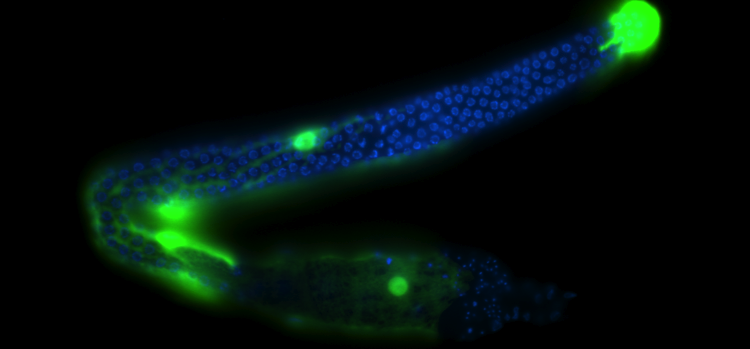
Regulation of Germline Proliferation & Differentiation by Direct Cell-Cell Communication: Sheath Cell–Germline Signaling
During the development and maintenance of tissues and organs, cells must decide whether, when, where, and how much to proliferate. Improper regulation of cell proliferation or differentiation can lead to developmental defects and cancer. Similar control mechanisms are shared in all organisms.
Using the genetically tractable C. elegans germ line as a system, researchers in the E. Jane Albert Hubbard Lab found a role for the distal-most pair of sheath cells (Sh1, see figure 1 from Killian and Hubbard, 2005) in the development of the germ line. This Sh1-germline signal collaborates with signaling by the Notch pathway from the distal tip cell (DTC) to the germ line to ensure robust larval progenitor accumulation.

Using our detailed knowledge of the development of a certain class of germline tumor mutants (Killian et al., 2004; Killian and Hubbard, 2005; McGovern et al., 2009), we developed an assay (see Hubbard, 2011) to identify the molecular basis for the Sh1-germline signal. This signaling is especially interesting since understanding its molecular basis will likely provide general insight into the nature of soma-germline signaling that underlies the developmental regulation of germline cell cycle progression.
While our assay has, so far, identified several important conserved pathways that influence germline development (see our work related to regulation of germline proliferation and differentiation by the environment: insulin, TOR, and TGFß), the key regulator from Sh1 has yet to be identified. Further analysis of the positive hits from our screens should identify the Sh1 signal. One hypothesis is that the signal from Sh1 will activate TOR in the germ line.
Relevant Publications
Tolkin T … Greenstein D. Innexin function dictates the spatial relationship between distal somatic cells in the Caenorhabditis elegans gonad without impacting the germline stem cell pool. Life. 2021. DOI.
Hubbard EJA and Schedl T. Biology of the Caenorhabditis elegans germline stem cell system. Genetics. 2019. DOI.
Hubbard EJ. Insulin and germline proliferation in Caenorhabditis elegans. Vitam Horm. 2011. DOI.
McGovern M … Hubbard EJ. A "latent niche" mechanism for tumor initiation. Proc Natl Acad Sci. 2009. DOI.
Killian DJ and Hubbard EJ. Caenorhabditis elegans germline patterning requires coordinated development of the somatic gonadal sheath and the germ line. Dev Biol. 2005 DOI.
Killian DJ and Hubbard EJ. C. elegans pro-1 activity is required for soma/germline interactions that influence proliferation and differentiation in the germ line. Development. 2004. DOI.